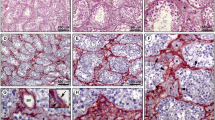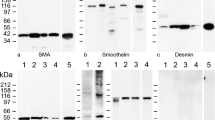Abstract
A light and electron microscope immunohistochemical study of the tunica albuginea from both young and elderly men was carried out to determine the distribution of the cells that contain actin, vimentin and/or desmin, and to evaluate the possible variations with ageing by means of quantitative studies. Testicular volume and testicular parenchyma volume decreased significantly with age whereas the tunica albuginea volume remained unchanged. These results agree with the scanty quantitative changes observed in the testicular connective tissue with age, and the notion that age-related changes in testicular volume are principally restricted to the seminiferous tubules. Three connective tissue layers could be distinguished in the tunica albuginea in both young and elderly men. The middle and inner layers increased in width with age while the width of the outer layer decreased. The average width of the tunica albuginea increased significantly with ageing. The tunica albuginea of young men and elderly men presented two types of fusiform cells: (1) fibroblast-like cells, which immunoreacted to actin and vimentin, but not to desmin; and (2) myoid cells, which immunoreacted to actin, vimentin and desmin. In both young men and elderly men, the total number of desmin-positive cells (myoid cells) was significantly lower than that of fibroblasts. However, the total number of desmin-positive cells was significantly increased in ageing men. In young testes, desmin-positive cells were more abundant in the outer layer of the tunica albuginea, whereas in elderly men these cells predominated in the middle layer. The increased desmin immunoexpression in the tunica albuginea of ageing men contrasts with the decrease in desmin immunoreaction in other myoid cells of the testis, the peritubular myoid cells, but only in seminiferous tubules that showed severe germ cell depletion. This suggests that changes in intermediate filament immunoexpression in peritubular cells are focalised, and thus, under local control, whereas changes in the tunica albuginea cells are generalised and possibly related to factors also affecting the connective tissue in other organs
Similar content being viewed by others
Author information
Authors and Affiliations
Additional information
Accepted: 15 January 1997
Rights and permissions
About this article
Cite this article
Arenas, M., Bethencourt, F., Fraile, B. et al. Immunocytochemical and quantitative study of the tunica albuginea testis in young and ageing men. Histochemistry 107, 469–477 (1997). https://doi.org/10.1007/s004180050134
Issue Date:
DOI: https://doi.org/10.1007/s004180050134




